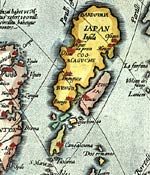|
Teachers'
Introductory Notes
 Access
to maps in the classroom has been revolutionised by
advances in technology over the last few years. This
project is part of this ongoing development. The continued
expansion of the Living Words website upholds The British
Library's commitment to make its collections available
to wider audiences. Access
to maps in the classroom has been revolutionised by
advances in technology over the last few years. This
project is part of this ongoing development. The continued
expansion of the Living Words website upholds The British
Library's commitment to make its collections available
to wider audiences.
The British
Library has a unique map and fascinating collection
and this project now allows you and your learners access
to some fascinating maps. One section of the maps has
been grouped into periods which correspond to the National
Curriculum History units for KS2/3. The other section
of the project, containing maps from every part of the
world, is arranged around a timeline to make it easy
for you to see exactly what is available to support
your particular teaching requirements.
 Each
map is accompanied by introductory text written with
KS2/3 learners as the intended audience. Beyond the
text there are a number of activities linked to individual
maps. These require the learner to interact with the
map on screen in some way. The intention is to draw
the learner into exploring the map further and either
finding specific details or offering explanations for
what they can see. It is almost certain that you will
see further opportunities, and create activities of
your own arising from the work you and your class are
engaged in. Each
map is accompanied by introductory text written with
KS2/3 learners as the intended audience. Beyond the
text there are a number of activities linked to individual
maps. These require the learner to interact with the
map on screen in some way. The intention is to draw
the learner into exploring the map further and either
finding specific details or offering explanations for
what they can see. It is almost certain that you will
see further opportunities, and create activities of
your own arising from the work you and your class are
engaged in.
Click
here to view a personal perspective by Dr.
Lez Smart, Lecturer in Education at Goldmsiths College,
University of London. He has a long history of using
maps in a classroom context and has written widely on
their use.
Credits
Content Author:
Dr. Lez Smart, Lecturer in Education at Goldmsiths
College,
University of London.
The British
Library researcher and content editor: Heather Crossley.
Web
development: site design, graphics and content creation,
and project
management: Footmark
Media Ltd. |
 |
Permission
to use the POW maps made by Philip Evans and the Brunwsick
Printers was kindly granted by Mark Evans.
With thanks
to Peter Barber.
|